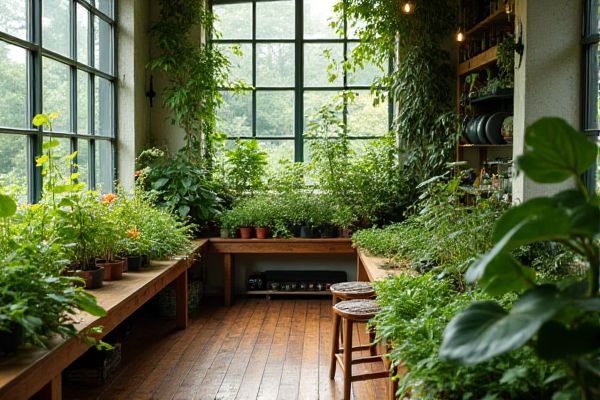
Hydroculture uses nutrient-rich water solutions to grow plants without soil, offering precise control over plant nutrition and reducing pest risks, while soil gardening relies on natural soil ecosystems to provide nutrients and support plant growth. Discover how choosing between hydroculture and soil gardening can impact your gardening success and which method suits your needs best by reading the full article.
Table of Comparison
| Aspect | Hydroculture | Soil Gardening |
|---|---|---|
| Medium | Water with nutrient solution | Natural soil |
| Water Usage | Efficient, recirculated water | Higher, often wasteful |
| Growth Speed | Faster due to direct nutrient access | Slower, dependent on soil quality |
| Space Efficiency | Compact setups, ideal for small areas | Requires larger space |
| Pest and Disease Control | Lower risk, controlled environment | Higher risk from soil-borne issues |
| Maintenance | Requires monitoring nutrient levels | Needs soil management and tilling |
| Cost | Higher initial investment | Lower startup cost |
| Sustainability | Water-saving, less chemical runoff | Depends on soil health, potential erosion |
Introduction to Hydroculture and Soil Gardening
Hydroculture utilizes a soil-free growing medium, relying on nutrient-rich water solutions to promote plant growth, which enhances nutrient absorption and reduces soil-borne diseases. Soil gardening depends on traditional soil, offering natural microorganisms and organic matter that support root development and plant health. Understanding these differences helps you choose the best cultivation method for your gardening goals and environmental conditions.
Key Differences Between Hydroculture and Soil Gardening
Hydroculture utilizes nutrient-rich water solutions for plant growth, promoting faster nutrient absorption and reduced soil-borne diseases compared to soil gardening, which relies on natural soil composition and microbial activity. Soil gardening supports beneficial organisms like earthworms and mycorrhizal fungi that enhance soil fertility and plant health, whereas hydroculture systems often require precise pH and nutrient balance monitoring to optimize growth conditions. Water efficiency is higher in hydroculture due to recirculation methods, contrasting with traditional soil gardening that depends on regular irrigation and natural rainfall.
Advantages of Hydroculture
Hydroculture offers precise nutrient control, allowing plants to receive optimal levels of minerals directly through water, which promotes faster growth compared to traditional soil gardening. This method reduces risks of soil-borne diseases and pests, minimizing the need for pesticides and enhancing plant health. You benefit from lower water usage and easier maintenance since hydroculture systems recycle water and eliminate the need for frequent soil replacement.
Advantages of Soil Gardening
Soil gardening offers natural nutrient cycles and supports beneficial microorganisms essential for healthy plant growth, making it a sustainable choice for your garden. The organic matter in soil improves water retention and aeration, promoting robust root systems and reducing the need for frequent watering. This method also allows for a diverse range of plant varieties to thrive, benefiting from the complex ecosystem within the soil.
Plant Growth and Yield Comparison
Hydroculture systems provide plants with direct access to nutrient-rich water solutions, often resulting in faster growth rates and higher yields compared to traditional soil gardening due to optimal oxygen and nutrient delivery. Soil gardening relies on natural soil composition and microbiota, which can vary widely and sometimes limit nutrient availability, potentially leading to slower growth and lower crop productivity. Your plant growth and yield can significantly improve with hydroculture by maintaining precise control over environmental factors and nutrient concentrations.
Environmental Impact: Hydroculture vs Soil
Hydroculture significantly reduces water usage by recycling nutrients in a controlled system, lowering environmental strain compared to traditional soil gardening, which often requires more water and can lead to soil degradation. Soil gardening contributes to carbon sequestration and supports biodiversity but may involve pesticide use and soil erosion, increasing the ecological footprint. Your choice between these methods impacts water conservation and soil health, with hydroculture offering a sustainable alternative in water-scarce environments.
Cost Analysis and Investment
Hydroculture systems typically require a higher initial investment due to the need for specialized equipment, such as pumps, reservoirs, and grow lights, compared to traditional soil gardening which mainly relies on soil and basic tools. Over time, hydroculture can reduce costs related to water usage and fertilizer due to its efficient recirculation systems, whereas soil gardening may incur ongoing expenses for soil amendments and pest control. Evaluating long-term returns, hydroculture's controlled environment often results in higher yields, potentially offsetting the startup costs through increased productivity.
Maintenance Requirements and Labor
Hydroculture requires less frequent watering and reduced pest control compared to soil gardening, minimizing daily maintenance efforts. Soil gardening demands regular soil aeration, weeding, and more intensive watering schedules to maintain plant health. Overall, hydroculture offers a labor-efficient alternative by streamlining nutrient delivery and environmental control.
Suitable Plants for Each Method
Hydroculture is ideal for growing plants like herbs, lettuce, and orchids that thrive in controlled, nutrient-rich water environments, while soil gardening suits root vegetables, tomatoes, and beans that benefit from natural soil ecosystems. Plants with shallow roots or those sensitive to overwatering perform better in hydroculture systems. Your choice could depend on the plant species' specific nutrient absorption needs and growth habits to maximize health and yield.
Choosing the Best Method for Your Needs
Hydroculture offers precise control over nutrient delivery and water usage, making it ideal for urban environments or limited space gardening. Soil gardening promotes natural microbial activity and biodiversity, benefiting plants requiring rich, organic matter and traditional care. Selecting between hydroculture and soil gardening depends on factors such as available space, maintenance preferences, and plant species requirements.
 homyna.com
homyna.com